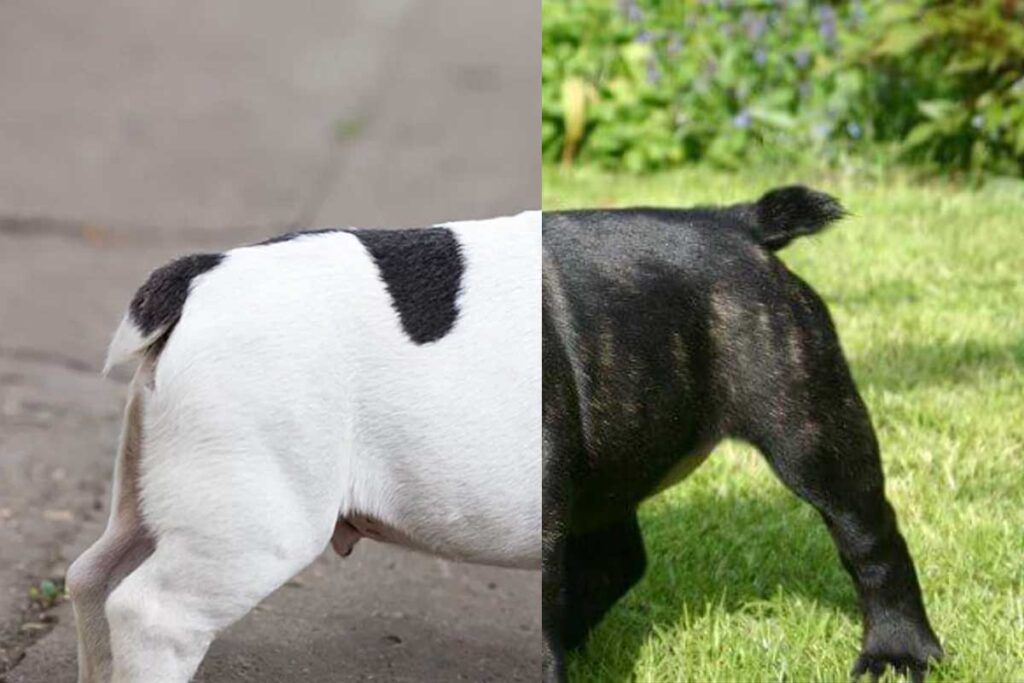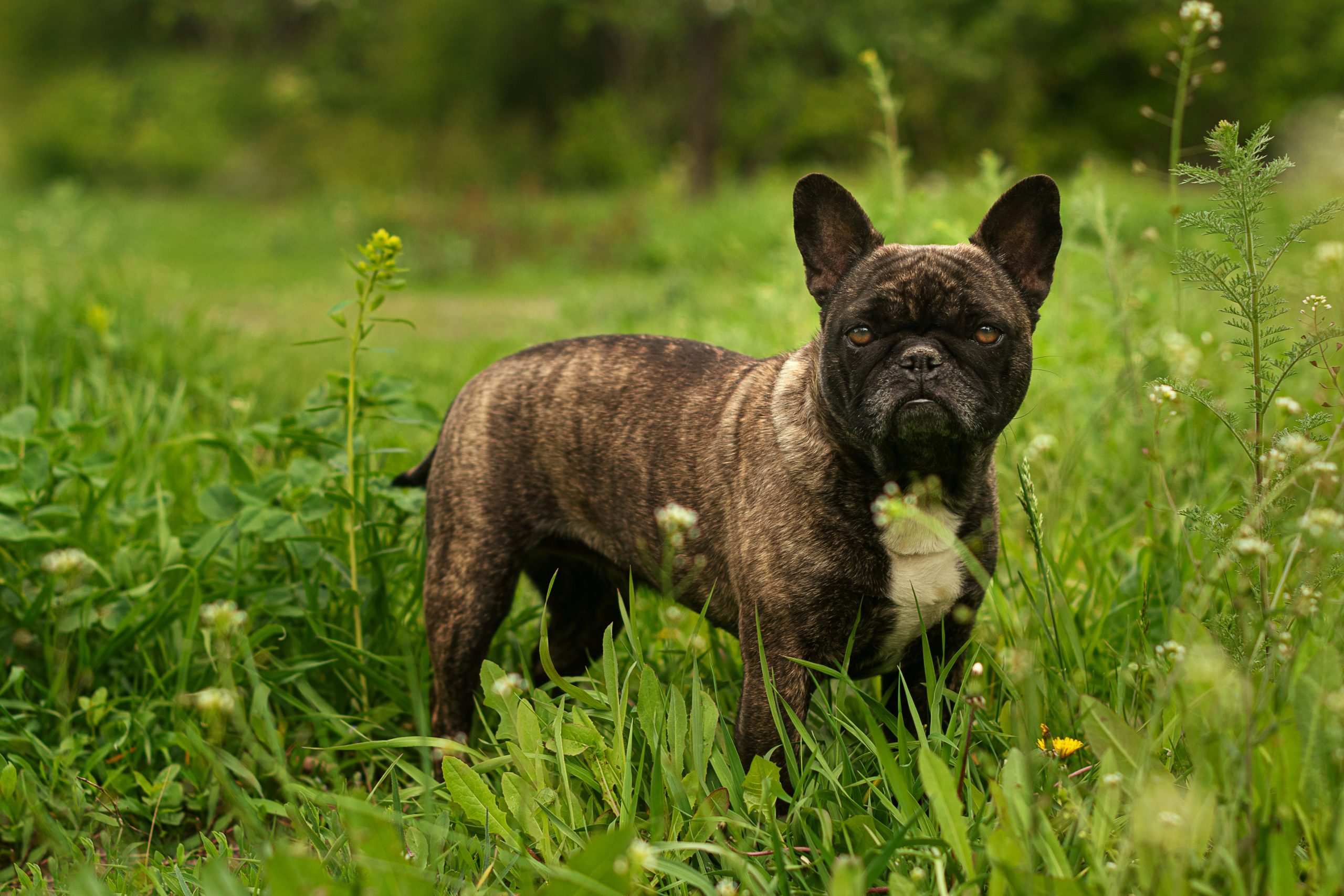When it comes to “French Bulldogs,” what would you think of first? Oftentimes, their perky ears or wrinkled, grumpy faces steal the spotlight. However, they have another unique feature that’s often overlooked. Once you notice it, it instantly sparks some curiosity, and you will find yourself unable to get your eyes of it. Yes, I’m talking about French Bulldog tail!
In this article, let’s reveal some truth about Frenchies’ tiny tails, debunk some myths, and explore common health conditions associated with this cutesy feature. Are you ready?
Anatomy of French Bulldog Tail

French Bulldog tails are as unique as the breed itself, with several distinct characteristics that set them apart from other dog breeds.
French Bulldogs typically have short, stumpy tails that rarely exceed 2-3 inches in length. This compact tail is a result of selective breeding over many generations, and it’s now a defining feature of the breed. The tail of a French Bulldog is composed of several vertebrae, muscles, and soft tissue. Despite its short length, it’s still an important part of the dog’s anatomy, playing a role in balance and communication.
When compared to other breeds, French Bulldog tails are notably shorter. While breeds like Labrador Retrievers or German Shepherds have long, expressive tails, Frenchies sport a more subtle appendage that adds to their compact, muscular appearance.
Types of French Bulldog Tails
Not all Frenchies’ tails are created equal. In fact, there are three main types of tails you might encounter in this breed.
Thick Root Tail
This type of tail is strong and well-connected to the dog’s body, giving the Bulldog a balanced structure. Owners often find that this type of tail is easier to maintain because it is less prone to complications.
Screw tails
Screw tails are the most recognizable of the French Bulldog tail varieties. These tails are tightly curled, often resembling a corkscrew or spiral. Frenchies with this physical feature often cost more than those with thick root tail or straight tail.
While this tail type is visually charming, it can sometimes cause skin problems or infections due to the folds where moisture or debris might get trapped. Regular cleaning and vet checkups are essential to prevent issues like dermatitis.
Read more >> Why are French Bulldogs so Expensive
Straight tails
Some French Bulldogs have straight tails, which are typically short but may stick out slightly more than screw tails. Though less curled, these tails still require attention to ensure they remain healthy. They are generally easier to clean compared to screw tails, though they still retain the breed’s signature shortness.
Tail Docking in French Bulldogs

Tail docking is a controversial practice that has been a topic of debate in the dog breeding community for years.
Historically, tail docking was performed on working dogs to prevent injury during their duties. However, for French Bulldogs, it’s important to note that their short tails are natural and not the result of docking. The practice of tail docking has come under scrutiny in recent years, with many animal welfare organizations arguing that it’s unnecessary and potentially harmful.
Many countries have banned or restricted tail docking for non-medical reasons. In the UK, for example, tail docking is illegal unless performed by a veterinarian for medical reasons. While French Bulldogs don’t typically undergo tail docking, it’s worth noting that any unnecessary surgical procedure carries risks. For breeds that are commonly docked, potential complications can include infection, chronic pain, and altered body language.
Common French Bulldog Tail Problems
While this feature might seem tiny, sometimes it can pose big problems. Here are some health concerns related to a Frenchie’s tail that pet parents should be aware of:
Hemivertebrae
This health condition used to be rare back then. Nowadays, though, it’s seen more and more in French Bulldogs with screw tails. The first stage of hemivertebrae is a deformity of a spine vertebrae, which may result in a twisted spine and potentially dangerous health consequences, such as pain or even paralysis in the rear limbs.
For management and therapy, early detection through physical exams is required.
Tail Pocket Infection
Some Frenchies were born with the “tail pocket” – a tiny area under their tails. While this feature is naturally harmless, dirt and bacteria might build up, causing infections if not cleaned frequently.
Symptoms of tail pocket infection are a bad odor, redness, and swelling. Preventing this condition requires routine cleaning and observation.
Sunburn
While this seems strange in other dogs, French Bulldogs are prone to sunburn of the tail due to their short hair and tail. This is especially true if your dog is lighter-colored. Before taking your dog out, we recommend using a pet-safe sunscreen to protect them. Also, for this breed, minimizing exposure during peak sunlight hours is advised.
Caring for Your French Bulldog Tail

Proper care of your French Bulldog’s tail is essential for their overall health and comfort. Regular cleaning of the tail area, especially the tail pocket, is crucial to prevent infections. Use a damp cloth or pet-safe wipe to gently clean the area daily. If your Frenchie loves to sunbathe, consider applying pet-safe sunscreen to their tail and other exposed areas to prevent sunburn. If you notice any redness, swelling, unusual odor, or if your dog seems to be in discomfort around their tail area, it’s time to consult with your veterinarian.
If your Frenchie has tail pockets, gently lift the tail and use a soft, damp cloth or pet-safe wipe to remove any debris or buildup. Be sure to dry the area thoroughly afterward to prevent moisture-related issues.
FAQs About French Bulldog Tails
Do French Bulldogs Have Tails?
Yes, French Bulldogs do have tails! While they’re short and sometimes barely visible, every French Bulldog is born with a tail. The compact, stumpy tail is a natural feature of the breed, not the result of docking.
What Kind of Diet is Needed to Properly Care for a French Bulldog Tail?
Although there isn’t a specific diet for tail health, a balanced, nutrient-rich diet is essential for maintaining healthy skin and coat, including the tail. Omega-3 fatty acids, found in the best food for French Bulldogs, can be especially helpful for promoting skin health and reducing inflammation.
Conclusion
French Bulldog tails may be small, but they play a big role in these adorable dogs’ lives. From their unique anatomy to the special care they require, understanding your Frenchie’s tail is an important part of responsible pet ownership. By staying vigilant about tail health and maintaining good hygiene practices, you can ensure that your French Bulldog’s tail remains as healthy and charming as the rest of them. Remember, a happy tail often means a happy dog!

As an experienced dog foster and canine advocate, I have a special place in my heart for French Bulldogs. Their charming personalities and unique needs sparked my interest, leading me to specialize in Frenchie care. I’ve fostered over 200 Frenchies over the year, gaining deep insights into their dietary requirements and health concerns. This expertise drives my contributions to bestfoodforfrenchbulldog.dog, where I share practical advice on nutrition, care, and enrichment for these lovable flat-faced pups.
My articles aim to educate Frenchie owners on optimal feeding practices and health management. When not writing or fostering, I’m often cuddling with my own Frenchie, Biscuit, my inspiration for helping others care for this delightful breed.

